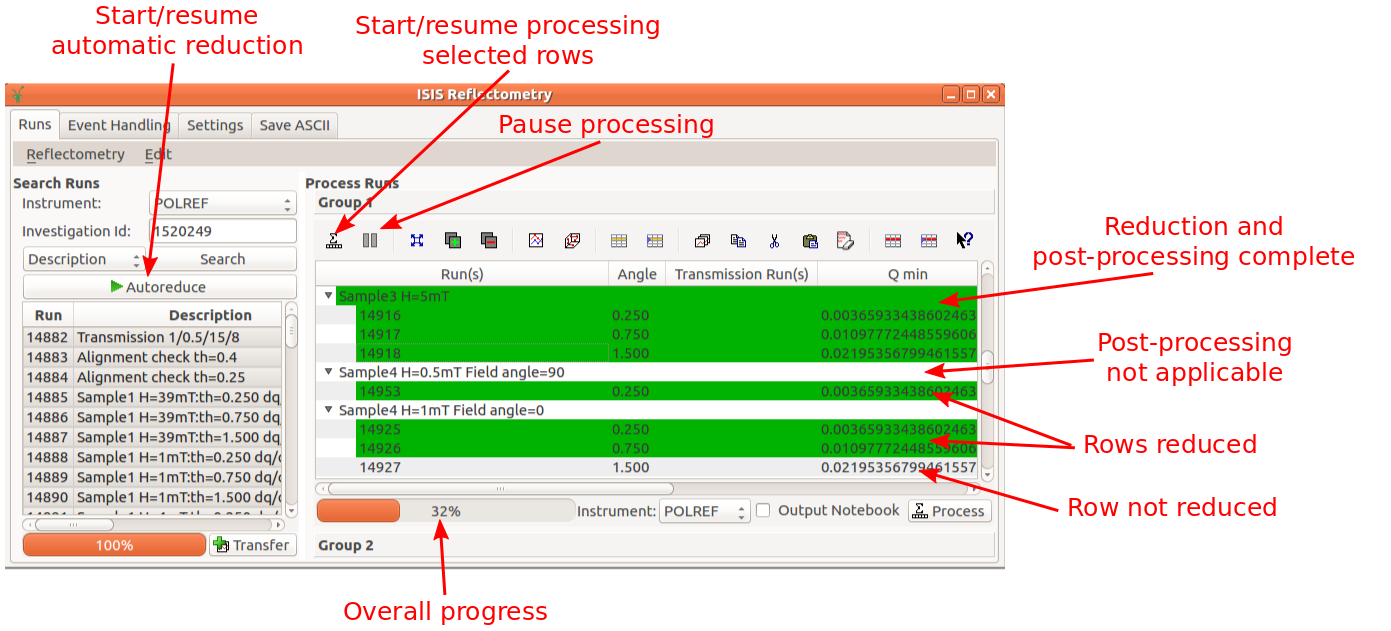Reflectometry Changes¶
Reflectometry Reduction Interface¶
ISIS Reflectometry¶

New features of the ISIS Reflectometry Interface¶
Automatic reduction¶
New ‘automatic reduction’ functionality has been added for automatically reducing all runs obtained from a given investigation ID.
With an investigation ID supplied, clicking
Autoreducesearches for runs that are included in the investigation, transfers them to the processing table and processes all runs.Automatic reduction can be paused using the new
Pausebutton. It can be resumed by pressing theAutoreducebutton again. This will continue the automatic reduction from the last processed row.Changing the instrument, investigation ID or transfer method while paused means that automatic reduction cannot continue where it left off. Therefore, clicking the
Autoreducebutton again will start a new automatic reduction based on the new settings.
Pausing and resuming reduction¶
A new
Pausebutton has been added which allows pausing of any reduction, whether started using theProcessorAutoreducebutton.The
ProcessandAutoreducebuttons are greyed out while a reduction is in progress. They are enabled again when the reduction is paused so that they can be used to resume the reduction.When the
Pausebutton is clicked, the reduction might not stop immediately, but will stop as soon as the current row has finished processing. This ensures that nothing is left in a partially-completed state.If the row selection is changed while a reduction is paused, the newly-selected rows will be processed instead of the original rows when the
Processbutton is clicked. However, the row selection is irrelevant when usingAutoreduce, because this will continue from the last-processed row.The interface cannot be closed while a reduction is in progress. Therefore, the
Pausebutton can be used to stop data reduction so that the interface can be closed.Data and settings should not be edited while a reduction is in progress. Pausing reduction allows changes to be safely made:
Rows and groups may be edited while a reduction is paused. They will be marked as ‘unprocessed’ so that they are re-processed when the reduction is resumed.
Altering data within a row will mean that its containing group will also be re-processed.
Adding/removing rows from a group will mean that the group will be re-processed.
Deleting or renaming output workspaces of processed rows/groups will mean that that row/group will be re-processed.
Other changes¶
Rows and groups that have been successfully processed are highlighted green:
Rows are highlighted when reduction has completed.
Groups are highlighted when post-processing has completed. Note that if a group does not have any applicable post-processing then it will never be highlighted, even if all of its child rows are highlighted.
The interface now operates asynchronously, so that one can still interact with the rest of MantidPlot while data is processing (instead of freezing MantidPlot until processing has finished).
The calculation of \(\frac{dQ}{Q}\) has been fixed in line with the changes to the NRCalculateSlitResolution v1 algorithm detailed below. An additional bug has been fixed where the interface was passing \(\theta\) to this algorithm instead of \(2\theta\).
ISIS Reflectometry (Old)¶
The calculation of \(\frac{dQ}{Q}\) has been fixed in line with the changes to the NRCalculateSlitResolution v1 algorithm. An additional bug has been fixed where the interface was passing \(\theta\) to this algorithm instead of \(2\theta\).
Algorithms¶
The following bugs have been fixed in the summation in Q functionality in ReflectometryReductionOne v2:
the incorrect angle was being used in the final conversion to Q in the divergent beam case
the input was being cropped, causing loss of counts
summation in Q was giving incorrect results for a point detector
The following new properties have been added to ReflectometryReductionOneAuto v3:
ThetaLogName: allows you to specify the name of a log value to use fortheta.CorrectDetectors: specifies whether detector positions should be corrected whenThetaInorThetaLogNameis provided. If true (default), detectors will be moved to the specifiedthetausing SpecularReflectionPositionCorrect v2. Otherwise,thetawill still be overridden but without detector positions being changed.Diagnostics: enable the output of additional interim workspaces for debug/validation.
A new version of SpecularReflectionCalculateTheta (version 2) has been added which works with detectors at \(2\theta\), in line with ReflectometryReductionOneAuto v3. Version 1 works with detectors at \(\theta\). Note that ReflectometryReductionOneAuto v3 has been adjusted so that its output is not affected.
The following changes have been made to CalculateResolution:
The algorithm has been renamed to NRCalculateSlitResolution v1 as this algorithm is specific to neutron reflectometry, and the resolution it calculates is the slit resolution.
Some errors in the resolution calculation have been fixed. Note that this affects the Q binning in the results of ReflectometryReductonOneAuto (versions 1 and 2) and ReflectometryReductionOne (version 1 only).
The
TwoThetaLogNameproperty has been replaced byThetaLogName. This still takesThetaas the default log name. This was causing confusion because it was being used as two theta; it is now being used as theta, as the new property name suggests.The output property
TwoThetaOuthas been removed because it is not useful. The algorithm now returns a single value which is the resolution.
LoadILLReflectometry v1 has been fixed to correctly load D17 files acquired in the TOF mode.